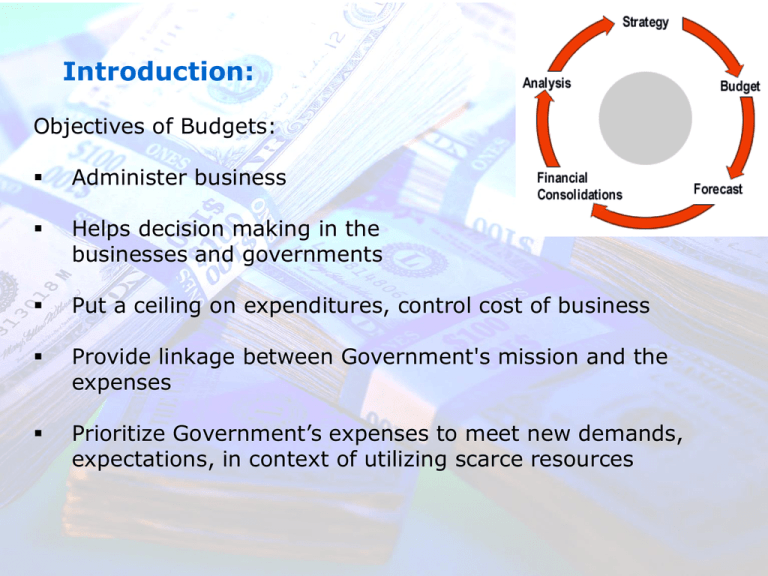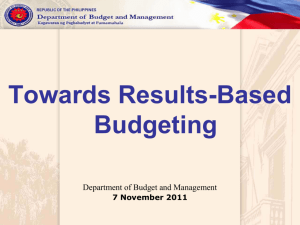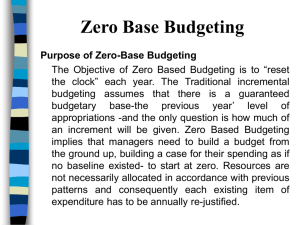Zero Base Budgeting
advertisement

Introduction: Objectives of Budgets: Administer business Helps decision making in the businesses and governments Put a ceiling on expenditures, control cost of business Provide linkage between Government's mission and the expenses Prioritize Government’s expenses to meet new demands, expectations, in context of utilizing scarce resources 1 Evolution of Zero Base Budgeting: Difference Line Item Budgeting Planning, Programming and Performance Budgeting (PPP) Zero Base Budgeting (ZBB) Accounting/ Number oriented Function oriented (Objectives) Function and priority based Input/ Output budgeting Dynamic Input/ Output budgeting Ongoing schemes taken for Granted Every year old/ new schemes evaluated together Resource allocation, with reference to results Resource allocation, in context of prioritization Cost-benefit, performance indicators Achievements in prioritized activity areas Features Input budgeting Dealing with Ongoing Schemes Ongoing schemes taken for granted Objective Control cost Justification of expenses Budget ceiling, approval, Appropriation 2 What is Zero Base Budgeting: ZBB introduces Management by Objectives through Financial Management Each year, budget starts from scratch (hence zero base) without considering earlier year’s resource allocation. Systematic application of marginal analysis techniques: Evaluate current and new programs on the basis of Output, performance, costs, utility, effectiveness, relevance, level, scarce resources and priorities Redefine resource allocation for activities: - Eliminate - Fund at reduced level - Fund at similar level - Fund higher level This helps to free up resources for new programs. 3 Planning & Budgeting Aspects: PLANNING BUDGET REVIEW Planning - Determination of Goals/Policies/ Objectives Zero Base Budgeting Evaluation Operational Plan - Identification & Evaluation -Trade off -Operational of all activities between plan -Alternatives & Costs to goals, plans achieve plan aims & costs -Establishment of priorities 4 Need for ZBB: It helps in allocating budgetary on more budgetary and allocating resources basis as below: How effectively and efficiently money is being spent? How much should be spent? How should be budget reduced? How should productivity and profitability may be increased? How effective and efficient are the current operations? Should current operations be reduced to fund higher priority items in progress? Flow of information to the top management for allocation of resources? 5 Benefits of ZBB: Cuts budget more rationally. Efficiency & profitability improved Provides coherency n better coordination between planning and budgeting Better insight into detailed working of organization Better evaluation of subordinate managers by top management Remove duplication/multiplication of expenditure Manage overheads better Enable the top management to reallocate resources with greater flexibility Enable better coordination between different departments of an organization Provides a tremendously effective information systems Enable managerial analysis at all levels 6 Limitations of ZBB: High costs More information requirements Takes up more time than traditional budgeting Attitudinal resistance from unions/Bureaucrats/Operational people, Lack of orientation/skills of prioritization New innovative decision packages are to be conceived, evaluated and compared which is difficult task Multi-level decision making procedures are required; this is difficult Information data retrieval is not necessary 7 Implementation of ZBB: Government of Maharashtra introduced ZBB on 16th December,1986 in each department to "get more out of every rupee spent”. Implementation of ZBB was primarily internalized by each administrative department. Savings effected by a department were not to be transferred to other departments but would be given to the same department to be spent in the priority areas. Steps used for effective productivity & efficiency: - Identify ways for cost-effective functioning - Review age old procedures - Delegate administrative/ financial work - Identify areas of cost recovery - Additional resource mobilization - Identifying items of work, which can be outsourced. 8 Results/ Major Achievements of ZBB implementation: Additional resource mobilization, simplification of procedures Replacement of legislative enactments Revision of fees matching the cost of service Computerization Identification of surplus manpower Review staff norms Review of schemes causing savings 9 Applications of Zero Based Budgeting: Government This is service sector, where overheads assume alarming figures, ZBB can control this up to large extent Unique example of Georgia Government over all its 65 paid agencies In India, Circulation to state governments in India by Ministry of Finance. Industries Applicable to all operations, administrative techniques and business enterprises. Prioritization and justification to all capital expenditures programme, cost reduction programmes, research development etc. 10 Approach of Maharashtra Government Progress and Constraints: Based on following cardinal management tenets: MBO through Financial Management Involvement of top management The principal of ‘Plural Executive’ in Administration ZBB application to total Governmental 11 Zero Based Budgeting in India: ZBB was first implemented in 1979 when the government considered its rigorous examination of its expenses. In 1986 a order was issued by the secretary, government of India that ZBB be applied for all its planned and non planned expenditures including PSU’s. 12 Issues faced, while implementation of ZBB: Defining of the objectives of the govt. The issue of the centralization and the decentralization of power. Government operations being ‘precedent’ oriented not creativity oriented. The MIS in the govt. is not well organized for ZBB implementation. Difficult of implementation in an ongoing scheme. It also leads to the problem of retrenchment. The ‘play safe approach’ & the resistance to change. ZBB has to be implemented in entirety and not piecemeal. 13 14 15 16







